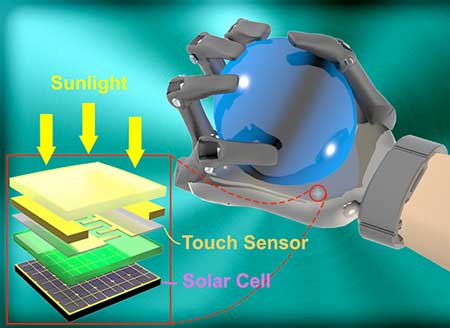| Jul 18, 2018 | |
Solar powered synthetic skin for robotics and prosthetics(Nanowerk News) A new way of harnessing the sun’s rays to power synthetic skin could help to create advanced prosthetic limbs capable of returning the sense of touch to amputees. |
|
| Professor Ravinder Dahiya and colleagues from his Bendable Electronics and Sensing Technologies (BEST) group’s initial breakthrough was to develop a touch-sensitive covering for prosthetic hands made from graphene. Looking for a functional way to power this electronic skin, they drew upon graphene’s remarkable physical properties to use energy from the sun. | |
| Funded by the Engineering and Physical Sciences Research Council, the group integrated power-generating photovoltaic cells into their electronic skin (Advanced Functional Materials, "Energy-Autonomous, Flexible, and Transparent Tactile Skin"). | |
 |
|
| Energy Autonomous e-skin. Diagram of layers show touch sensor and solar cell. (Image: University of Glasgow) | |
| Graphene is a highly flexible form of graphite which, despite being just a single atom thick, is stronger than steel, electrically conductive, and transparent. It is graphene’s optical transparency, which allows around 98% of the light which strikes its surface to pass directly through it, which makes it ideal for gathering energy from the sun to generate power. | |
Synthetic skin for prosthetics |
|
| Human skin is an incredibly complex system capable of detecting pressure, temperature and texture through an array of neural sensors which carry signals from the skin to the brain. | |
| "We have already made significant steps in creating prosthetic prototypes which integrate synthetic skin and are capable of making very sensitive pressure measurements," says Prof. Dahiya. "Those measurements mean the prosthetic hand is capable of performing challenging tasks like properly gripping soft materials, which other prosthetics can struggle with. We are also using innovative 3D printing strategies to build more affordable sensitive prosthetic limbs. | |
| "Skin capable of touch sensitivity also opens the possibility of creating robots capable of making better decisions about human safety. A robot working on a construction line, for example, is much less likely to accidentally injure a human if it can feel that a person has unexpectedly entered their area of movement and stop before an injury can occur." | |
| The group has advanced their synthetic skin prototype to so it that is now fully flexible. It comprises a flexible graphene-based touch-sensitive layer integrated on flexible solar cell. This gives it the potential to enable the detailed movements required by an advanced prosthetic. The new skin requires just 20 nanowatts of power per square centimetre, which is easily met even by the poorest-quality photovoltaic cells currently available on the market. | |
Energy storage in the skin |
|
| A key breakthrough for the group has occurred since they published their original research into the use of solar energy in March 2017. At that time, they were not able to store the excess energy produced by the skin’s photovoltaic cells. | |
| Their research has now advanced so that excess energy can be stored in flexible ultra-thin high-performance supercapacitors based within the skin. Not only does this improve the effective use of skin in robotics and prosthetics, this advance opens up new possibilities for other technologies. Any innovation that requires flexible, light-weight, ultra-thin energy storage solutions could utilise this technology, such as drones or wearable technology. | |
| "The next step for us is to further develop the power-generation technology which underpins this research and use it to power the motors which drive the prosthetic hand itself. This could allow the creation of an entirely energy-autonomous prosthetic limb," says Prof. Dahiya. "We’ve already made some encouraging progress in this direction and we’re looking forward to presenting those results soon. We are also exploring the possibility of building on these exciting results to develop wearable systems for affordable healthcare. In this direction, recently we also got small funds from Scottish Funding Council." |
| Source: University of Glasgow | |
|
Subscribe to a free copy of one of our daily Nanowerk Newsletter Email Digests with a compilation of all of the day's news. |
